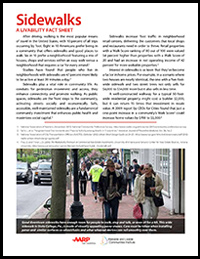AARP Hearing Center
Sidewalks play a vital role in community life. As conduits for pedestrian movement and access, they enhance connectivity and promote walking. As public spaces, sidewalks are the front steps to a community, activating streets both socially and economically.
It makes little sense that in so many neighborhoods, sidewalks are rare and even non-existent.
Key Points
Among the benefits of sidewalks:
- People who live in neighborhoods with sidewalks are 47 percent more likely to be active at least 39 minutes a day.
- A well-constructed walkway for a typical 50-foot-wide residential property might cost a builder $2,000, but it can return 15 times that investment in resale value.
- In a scenario where two houses are nearly identical, the one with a five-foot-wide sidewalk and two street trees not only sells for $4,000 to $34,000 more but it also sells in less time.
- Retail properties with a Walk Score ranking of 80 out of 100 were valued 54 percent higher than properties with a Walk Score of 20 and had an increase in net operating income of 42 percent for more walkable properties.
While having a sidewalk is generally better than not having a sidewalk (provided the sidewalk in question is in good repair), certain types of sidewalks are better than others, and a sidewalk's width is key. In busy downtown neighborhoods that have lots of people, destinations and potential conflicts with vehicles, sidewalks need to be wide enough to handle foot traffic and community features such as cafe seating, benches and other spots for socializing.
A width of at least eight to 12 feet is the typical recommendation for downtown settings while a five to seven foot expanse is usually more than enough in a residential area.































































